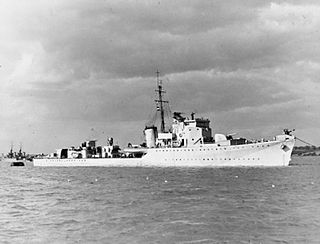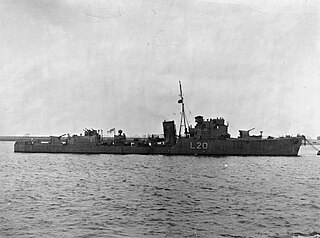
HMS Kelvin was a K-class destroyer of the Royal Navy laid down by the Fairfield Shipbuilding and Engineering Company, Limited, at Govan in Scotland on 5 October 1937, launched on 19 January 1939 and commissioned on 27 November 1939 with the pennant number F37.

The Halcyon class was a class of 21 oil-fired minesweepers built for the British Royal Navy between 1933 and 1939. They were given traditional small ship names used historically by the Royal Navy and served during World War II.

HMS Whaddon (L45) was a Type I Hunt-class destroyer of the Royal Navy built by Alexander Stephen & Sons of Linthouse, Govan and launched on 16 July 1940. She was laid down on 27 July 1939 and commissioned 28 February 1941. She was adopted by the civil community of Newport Pagnell in Buckinghamshire, as part of the Warship Week campaign in 1942.

The second HMS Hambledon was a Hunt-class destroyer of the Royal Navy in commission from 1940 to 1945. She was a member of the first subgroup of the class, and saw service throughout World War II.

HMS Vivacious (D36) was a V-class destroyer of the British Royal Navy that saw service in World War I and World War II.

HMS Venomous (ex-Venom), was a Modified W-class destroyer of the British Royal Navy that saw service in the Russian Civil War and World War II.

The third HMS Windsor (D42) was a W-class destroyer of the British Royal Navy that saw service in the final months of World War I and in World War II.

The second HMS Wivern, was a Modified W-class destroyer of the British Royal Navy that saw service in World War II.

The eighth HMS Worcester, was a Modified W-class destroyer of the British Royal Navy that saw service in World War II. She later served as an accommodation ship as the second HMS Yeoman.

HMS Oakley was a Type II Hunt-class destroyer of the Royal Navy. She was originally to have been named Tickham, however she was renamed after her sister ship Oakley was transferred to Poland and was renamed ORP Kujawiak (L72). She entered service in May 1943, carrying out convoy escort, patrol and anti-shipping attacks for most of the rest of the Second World War. She was adopted by the Civil community of Leighton Buzzard in Bedfordshire as part of Warship Week in 1942. In 1957, she was sold to the West German Navy, serving as a training ship for the German Naval Gunnery school until scrapped in 1972.

HMS Garth was a Type I Hunt-class destroyer of the Royal Navy built by John Brown & Company on the River Clyde, and launched on 28 December 1939. She was adopted by the Civil Community of Wokingham, Berkshire, as part of the Warship Week campaign in 1942.

HMS Holderness was a Type I Hunt-class destroyer of the Royal Navy which served in World War II. She was scrapped in 1956.

HMS Cotswold was a Type I Hunt-class destroyer of the Royal Navy which served in World War II. She was scrapped in 1957.

HMS Southdown was a Type I Hunt-class destroyer of the Royal Navy which served in World War II. She was scrapped in 1956.

HMS Cowdray was a Type II Hunt-class destroyer of the Royal Navy which served in World War II. She has been the only Royal Navy ship to bear the name. She was scrapped in 1959.

HMS Farndale was a Type 2 Hunt-class destroyer of the Royal Navy which served in World War II. She was scrapped in 1962. She has been the only British Warship so far to bear this name.

HMS Wilton was a Type 2 Hunt-class destroyer of the Royal Navy that served in the Second World War.

HMS Lauderdale was a Hunt-class destroyer of the Royal Navy. Ships of this class were designed as cheap, easily built vessels for convoy escort and antisubmarine duties. She was named like her sisters after a fox hunt, in her case one in Berwickshire. War bonds were issued to finance the building of warships. During Warship Week held in 1942 the civil community of Berwickshire adopted the ship. She has been the only Royal Navy warship to carry this name.

HMS Belvoir was a Hunt-class destroyer of the Royal Navy. She was a member of the third subgroup of the class, and saw service in the Second World War. She was adopted by the civil community of Sutton in Ashfield, Nottinghamshire during Warship Week in 1942.
HMS Fernie was a Type I Hunt-class destroyer built for the Royal Navy completed in mid-1940. She was adopted by the Civil Community of Market Harborough, Leicestershire, as part of the Warship Week campaign in 1942. She has been the only ship in the Royal Navy to carry this name.



















